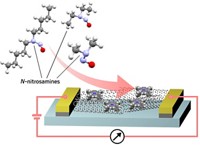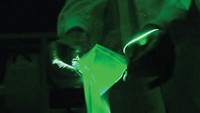Advertisement
Grab your lab coat. Let's get started
Welcome!
Welcome!
Create an account below to get 6 C&EN articles per month, receive newsletters and more - all free.
It seems this is your first time logging in online. Please enter the following information to continue.
As an ACS member you automatically get access to this site. All we need is few more details to create your reading experience.
Not you? Sign in with a different account.
Not you? Sign in with a different account.
ERROR 1
ERROR 1
ERROR 2
ERROR 2
ERROR 2
ERROR 2
ERROR 2
Password and Confirm password must match.
If you have an ACS member number, please enter it here so we can link this account to your membership. (optional)
ERROR 2
ACS values your privacy. By submitting your information, you are gaining access to C&EN and subscribing to our weekly newsletter. We use the information you provide to make your reading experience better, and we will never sell your data to third party members.

With each drag on a cigarette, a smoker inhales thousands of chemicals, many of which are toxic or carcinogenic. German researchers have now demonstrated a new separation and detection technique that tracks, puff by puff, the chemical makeup of cigarette smoke (Anal. Chem., DOI: 10.1021/ac201070j).
Most studies look at an entire cigarette’s worth of smoke: For example, researchers collect and analyze aerosol particles that have adsorbed onto a filter pad throughout a cigarette’s lifetime. But these analyses can miss specific compounds, because some chemicals in cigarette smoke degrade quickly, and because the mix of chemicals changes as the smoker burns through the cigarette.
Attempts to measure the smoke’s contents puff by puff have met limited success, says Ralf Zimmermann of the Helmholtz Center Munich. He says the problem is that many of smoke’s compounds have similar masses, making them difficult to separate and analyze in real time.
Zimmermann and his colleagues developed a system that consists of a smoking machine attached to a gas chromatograph and a mass spectrometer. During each minute the machine puffs on a cigarette, it collects two seconds’ worth of smoke. The gas chromatograph then separates that sample’s chemical components.
The researchers solved the problems that previous puff-by-puff studies encountered through their choice of mass spectrometry technique. Their mass spectrometer ionizes molecules using a gentle technique called single-photon ionization that provides another step of separation after the gas chromatograph. This ionization technique also simplifies the subsequent data interpretation because it doesn’t fragment incoming molecules.
With their new system, the researchers measured the concentrations over time of 14 hazardous compounds, including benzene and acetaldehyde. For most chemicals, the levels in each puff increased during the cigarette’s lifetime. When the researchers calculated the total amounts of the 14 compounds released by the cigarette, the results agreed with measurements other researchers had made using other methods.
The method could have commercial potential if industry or regulators start to require puff-by-puff analysis, says Kevin Wilkinson, a scientist at Enthalpy Analytical, an air quality testing company in Durham, N.C. Since passage of the 2009 Family Smoking Prevention and Tobacco Control Act, the Food and Drug Administration can regulate the manufacture of cigarettes and other tobacco products.
Cigarette smoke is just one potential application of the technique, Zimmermann says. It could monitor the changes in many types of aerosol mixtures, such as car or industrial exhaust, as well as flavor components in food. Two of his former students have started a company, Photonion, to commercialize the mass spectrometry technique.





Join the conversation
Contact the reporter
Submit a Letter to the Editor for publication
Engage with us on Twitter